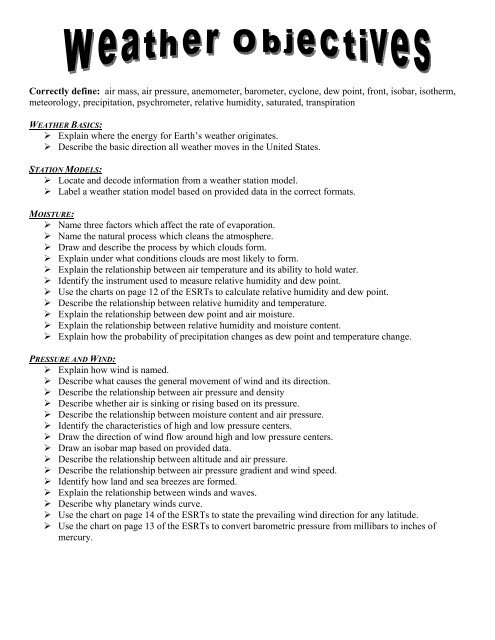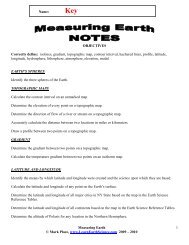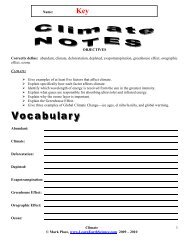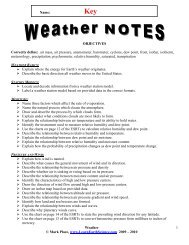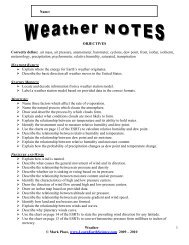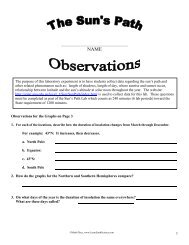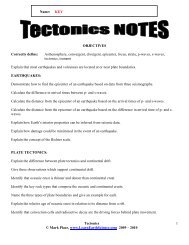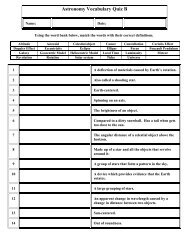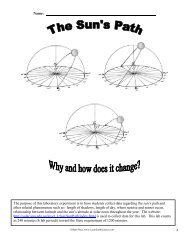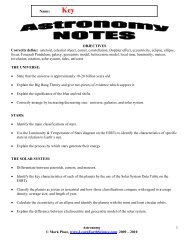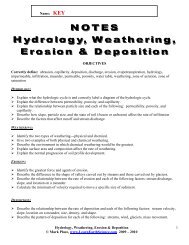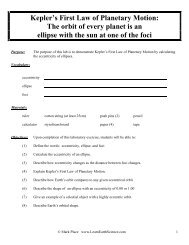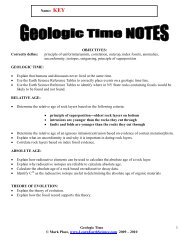Weather - Learn Earth Science
Weather - Learn Earth Science
Weather - Learn Earth Science
- No tags were found...
You also want an ePaper? Increase the reach of your titles
YUMPU automatically turns print PDFs into web optimized ePapers that Google loves.
Correctly define: air mass, air pressure, anemometer, barometer, cyclone, dew point, front, isobar, isotherm,meteorology, precipitation, psychrometer, relative humidity, saturated, transpirationWEATHER BASICS:‣ Explain where the energy for <strong>Earth</strong>’s weather originates.‣ Describe the basic direction all weather moves in the United States.STATION MODELS:‣ Locate and decode information from a weather station model.‣ Label a weather station model based on provided data in the correct formats.MOISTURE:‣ Name three factors which affect the rate of evaporation.‣ Name the natural process which cleans the atmosphere.‣ Draw and describe the process by which clouds form.‣ Explain under what conditions clouds are most likely to form.‣ Explain the relationship between air temperature and its ability to hold water.‣ Identify the instrument used to measure relative humidity and dew point.‣ Use the charts on page 12 of the ESRTs to calculate relative humidity and dew point.‣ Describe the relationship between relative humidity and temperature.‣ Explain the relationship between dew point and air moisture.‣ Explain the relationship between relative humidity and moisture content.‣ Explain how the probability of precipitation changes as dew point and temperature change.PRESSURE AND WIND:‣ Explain how wind is named.‣ Describe what causes the general movement of wind and its direction.‣ Describe the relationship between air pressure and density‣ Describe whether air is sinking or rising based on its pressure.‣ Describe the relationship between moisture content and air pressure.‣ Identify the characteristics of high and low pressure centers.‣ Draw the direction of wind flow around high and low pressure centers.‣ Draw an isobar map based on provided data.‣ Describe the relationship between altitude and air pressure.‣ Describe the relationship between air pressure gradient and wind speed.‣ Identify how land and sea breezes are formed.‣ Explain the relationship between winds and waves.‣ Describe why planetary winds curve.‣ Use the chart on page 14 of the ESRTs to state the prevailing wind direction for any latitude.‣ Use the chart on page 13 of the ESRTs to convert barometric pressure from millibars to inches ofmercury.
AIR MASSES AND FRONTS:‣ Explain how air masses get their properties.‣ Identify the temperature and moisture content of air masses based on their abbreviations.‣ Identify where an air mass would likely form based on its characteristics.‣ Draw an isotherm map based on provided data.‣ Identify a warm or cold front on a weather map.‣ Draw a profile showing how a cold or warm front looks on the ground.‣ Identify the key characteristics associated with cold and warm fronts.‣ Draw warm and cold fronts on a weather map based on air mass characteristics.HAZARDOUS WEATHER AND SAFETY:‣ Identify other names for hurricanes and tornadoes.‣ Describe the type of weather and dangers associated with hurricanes and tornadoes.‣ Describe hurricanes and tornadoes are different regarding geographical scale.‣ Describe appropriate safety precautions to take for both tornadoes and hurricanes.


